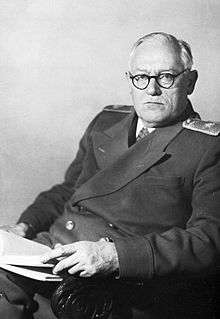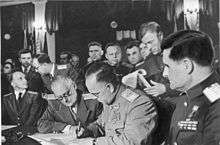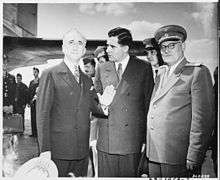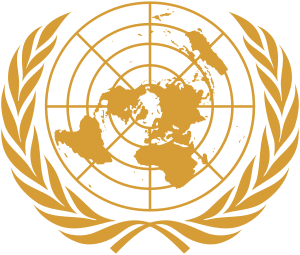Andrey Vyshinsky
Andrey Yanuaryevich Vyshinsky (Russian: Андре́й Януа́рьевич Выши́нский; Polish: Andrzej Wyszyński) (10 December [O.S. 28 November] 1883 – 22 November 1954) was a Soviet politician, jurist and diplomat.
Andrey Vyshinsky Андре́й Выши́нский | |
|---|---|
 Andrey Vyshinsky in 1940 | |
| Minister of Foreign Affairs | |
| In office 4 March 1949 – 5 March 1953 | |
| Premier | Joseph Stalin |
| Preceded by | Vyacheslav Molotov |
| Succeeded by | Vyacheslav Molotov |
| Procurator General of the Soviet Union | |
| In office 3 March 1935 – 31 May 1939 | |
| Premier | Vyacheslav Molotov |
| Preceded by | Ivan Akulov |
| Succeeded by | Mikhail Pankratov |
| Procurator General of the Russian SFSR | |
| In office 11 May 1931 – 25 May 1934 | |
| Premier | Vyacheslav Molotov |
| Preceded by | Nikolai Krylenko |
| Succeeded by | Vladimir Antonov-Ovseyenko |
| Candidate member of the 19th Presidium | |
| In office 16 October 1952 – 6 March 1953 | |
| Personal details | |
| Born | Andrey Yanuaryevich Vyshinsky 10 December 1883 Odessa, Kherson Governorate, Russian Empire |
| Died | 22 November 1954 (aged 70) New York City, New York, United States |
| Nationality | Soviet |
| Political party | Russian Communist Party (1920-1954) |
| Profession | Lawyer, diplomat, civil servant |
| Signature |  |
He is known as a state prosecutor of Joseph Stalin's Moscow trials and in the Nuremberg trials. He was the Soviet Foreign Minister from 1949 to 1953, after having served as Deputy Foreign Minister under Vyacheslav Molotov since 1940. He also headed the Institute of State and Law in the Soviet Academy of Sciences.
Biography
Early life
Vyshinsky was born in Odessa into a Polish Catholic family,[1] who later moved to Baku. His father, Yanuarii Vyshinsky (January Wyszyński), as his earlier biographies state, was a "well-prospering" "experienced inspector" (Russian: Ревизор),[2][3][4] while his later, undocumented Stalin-era biographies such as "The Great Soviet Encyclopedia" (Russian: Большая советская энциклопедия, Bolshaya sovetskaya entsiklopediya) make him a pharmaceutical chemist. A talented student, Andrey Vyshinsky married Kara Mikhailova, and became interested in revolutionary ideas. He began attending the Kiev University but was expelled for participating in revolutionary activities.[5]
Vyshinsky returned to Baku, became a Menshevik in 1903 and took an active part in the 1905 Russian Revolution. As a result, in 1908 he was sentenced to prison and a few days later was sent to Bailov prison to serve his sentence.[6] Here he first met Stalin: a fellow inmate with whom he engaged in ideological disputes.[7] After his release, he returned home to Baku for the birth of his daughter Zinaida in 1909. Soon thereafter, he returned to Kiev University and did quite well. He was even considered for a professorship, but his political past caught up with him, and he was forced to return to Baku.[8] Determined to practice law, he tried Moscow, where he became a successful lawyer, remained an active Menshevik, gave many passionate and incendiary speeches, and became involved in city government.[9]
Russian Civil War
In 1917, as a minor official, he undersigned an order to arrest Vladimir Lenin,[10] according to the decision of the Russian Provisional Government, but the October Revolution quickly intervened, and the offices which had ordered the arrest were dissolved.[11] In 1917, he became reacquainted with Stalin, who had become an important Bolshevik leader. Consequently, he joined the staff of the People's Commissariat of Food, which was responsible for Moscow's food supplies, and with the help of Stalin, Alexei Rykov, and Lev Kamenev, he began to rise in influence and prestige.[12] In 1920, after the defeat of the Whites under Denikin, and the end of the Russian Civil War, he joined the Bolsheviks.[13]
Bolsheviks in power
.jpg)
Becoming a member of the nomenklatura he became a prosecutor in the new Soviet legal system, began a rivalry with a fellow lawyer, Nikolai Krylenko, and in 1925 was elected rector of Moscow University, which he began to clear of "unsuitable" students and professors.[14]
In 1928, he presided over the "Shakhty Trial" against 53 alleged counter-revolutionary "wreckers."[15] Krylenko acted as prosecutor, and the outcome was never in doubt. As historian Arkady Vaksberg explains, "all the court's attention was concentrated not on analysing the evidence, which simply did not exist, but on securing from the accused confirmation of their confessions of guilt that were contained in the records of the preliminary investigation."[16]
In 1930, he acted as co-prosecutor with Krylenko at another show trial, which was accompanied by a storm of propaganda. In this case, all eight defendants confessed their guilt. As a result, he was promoted.[17]
He carried out administrative preparations for a "systematic" drive "against harvest-wreckers and grain-thieves."[18]
Procurator General and Soviet law theorist

In 1935 he became Procurator General of the USSR, the legal mastermind of Joseph Stalin's Great Purge. Although he acted as a judge, he encouraged investigators to procure confessions from the accused. In some cases, he prepared the indictments before the "investigation" was concluded.[19] In his Theory of Judicial Proofs in Soviet Justice (Stalin Prize in 1947) he laid a theoretical base for the Soviet judicial system, based on Marxist–Leninist principles, giving it a strong bias towards dialectical and collectivist thinking. Vyshinsky recommended that investigators and judges consider "the wider social perspective" of each individual case in the context of class struggle. As a result, an actual commission of a crime was not required for conviction: people could have been convicted for being perceived as bourgeois ("class responsibility") or simply if that was considered to be beneficial for the Communist Party, for example in the "educational" role of the judicial system (thus, the importance of show trials, even with completely false accusations). Many of the rules introduced were mutually exclusive: for example, Vyshinsky generally warned against treating self-indictment as a formal proof due to possible manipulation, but at the same time he warned against "treating this rule in abstraction from specific characteristics of each case" in "cases of conspiracy, criminal organisations, and especially cases of anti-Soviet and counterrevolutionary groups". He also used his own speeches from the Moscow Trials as an example of how defendants' statements could be used as primary evidence in such cases, as the prosecution "cannot expect that the conspirators would document their criminal activities".[20] Perhaps based on this practice, in which according to Vaksberg, Stalin personally gave direction on the use of confessions and the use of the death penalty, Vyshinsky is cited for the principle that "confession of the accused is the queen of evidence".[21]
Vyshinsky first became a nationally known public figure as a result of the Semenchuk case of 1936.[22] Konstantin Semenchuk was the head of the Glavsevmorput station on Wrangel Island. He was accused of oppressing and starving the local Yupik and of ordering his subordinate, the sledge driver Stepan Startsev, to murder Dr. Nikolai Vulfson, who had attempted to stand up to Semenchuk, on 27 December 1934 (though there were also rumours that Startsev had fallen in love with Vulfson's wife, Dr. Gita Feldman, and killed him out of jealousy).[23] The case came to trial before the Supreme Court of the RSFSR in May 1936; both defendants, attacked by Vyshinsky as "human waste," were found guilty and shot, and "the most publicised result of the trial was the joy of the liberated Eskimos."[24]
In 1936, Vyshinsky achieved international infamy as the prosecutor at the Zinoviev-Kamenev trial (this trial had nine other defendants), the first of the Moscow Trials during the Great Purge, lashing its defenseless victims with vituperative rhetoric:[25]
Shoot these rabid dogs. Death to this gang who hide their ferocious teeth, their eagle claws, from the people! Down with that vulture Trotsky, from whose mouth a bloody venom drips, putrefying the great ideals of Marxism!... Down with these abject animals! Let's put an end once and for all to these miserable hybrids of foxes and pigs, these stinking corpses! Let's exterminate the mad dogs of capitalism, who want to tear to pieces the flower of our new Soviet nation! Let's push the bestial hatred they bear our leaders back down their own throats!
He often punctuated speeches with phrases like "Dogs of the Fascist bourgeoisie," "mad dogs of Trotskyism," "dregs of society," "decayed people," "terrorist thugs and degenerates," and "accursed vermin."[26] This dehumanization aided in what historian Arkady Vaksberg calls "a hitherto unknown type of trial where there was not the slightest need for evidence: what evidence did you need when you were dealing with 'stinking carrion' and 'mad dogs'?"[27]
During the trial of Bukharin, Vyshinsky characterized him as an "accursed crossbreed of fox and pig" who supposedly committed a "whole nightmare of vile crimes".
He is also attributed as the author of an infamous quote from the Stalin era: "Give me a man and I will find the crime."[28]
During the trials, Vyshinsky misappropriated the house and money of Leonid Serebryakov (one of the defendants of the infamous Moscow Trials), who was later executed.[29] Adolf Hitler held Vyshinsky in high esteem, stating that Roland Freisler is "our Vyshinsky".
Wartime diplomat
The Great Purge inflicted tremendous losses on the People's Commissariat of Foreign Affairs. Maxim Litvinov was one of the few diplomats who survived and he was dismissed. Vyshinsky had a low opinion of diplomats because they often complained about the effect of trials on opinions in the West.[30]
In 1939, Vyshinsky entered another phase of his career when he introduced a motion to bring the Western Ukraine into the USSR to the Supreme Soviet.[31] Afterwards, as Deputy Chairman of the People's Commissariat, which oversaw culture and education, as this area and others were incorporated more fully into the USSR, he directed efforts to convert the written alphabets of conquered peoples to the Cyrillic alphabet.[31]
In June 1940 Vyshinsky was sent to Latvia[32] to supervise the establishment of a pro-Soviet government and incorporation of that country into the USSR. He was generally well received, and he set out to purge the Latvian Communist Party of Trotskyists, Bukharinites, and possible foreign agents. In July 1940, a Latvian Soviet Republic was proclaimed. It was, unsurprisingly, granted admission to the USSR. As a result of this success, he was named Deputy People's Commissar of Foreign Affairs, and taken into greater confidence by Stalin, Lavrentiy Beria, and Vyacheslav Molotov.[33]
After the German invasion of the Soviet Union Vyshinsky was transferred to the shadow capital at Kuibyshev. He remained here for much of the war, but he continued to act as a loyal functionary, and attempted to ingratiate himself with Archibald Clark Kerr and visiting Republican presidential candidate Wendell Willkie.[34] During the Tehran Conference in 1943, he remained in the Soviet Union to "keep shop" while most of the leadership was abroad.[35] Stalin appointed him to the Allied Control Council on Italian affairs where he began organizing the repatriation of Soviet POWs (including those who did not want to return to the Soviet Union). He also began to liaise with the Italian Communist Party in Naples.[36]

In February 1945, he accompanied Stalin, Molotov, and Beria to the Yalta Conference.[37] After returning to Moscow he was dispatched to Romania, where he arranged for a Communist regime to assume control in 1945.[38] He then once again accompanied the Soviet leadership to the Potsdam Conference.
British diplomat Sir Frank Roberts, who served as British Chargé d'Affaires in Moscow from February 1945 to October 1947, described him as follows:
He spoke good French, was quick, clever and efficient, and always knew his dossier well, but whereas I had a certain unwilling respect for Molotov, I had none at all for Vyshinsky. All Soviet officials at that time had no choice but to carry out Stalin's policies without asking too many questions, but Vyshinsky above all gave me the impression of a cringing toadie only too anxious to obey His Master's Voice even before it had expressed his wishes. ... I always had the feeling with Vyshinsky that his past as a Menshevik together with his Polish and bourgeois background made him particularly servile and obsequious in his dealings with Stalin and to a lesser extent with Molotov.[39]
Post-Second World War

He was responsible for the Soviet preparations for the trial of the major German war criminals by the International Military Tribunal.
In 1953, he was among the chief figures accused by the U.S. Congress Kersten Committee during its investigation of the Soviet occupation of the Baltic states.[40]
The positions he held included those of vice-premier (1939–1944), Deputy Minister of Foreign Affairs (1940–1949), Minister of Foreign Affairs (1949–1953), Academician of the Soviet Academy of Sciences from 1939, and permanent representative of the Soviet Union to the United Nations.
He died of heart attack in 1954 while in New York and was buried near Red Square.
Scholarship
Vyshinsky was the director of the Soviet Academy of Sciences' Institute of State and Law. Until the period of destalinization, the Institute of State and Law was named in his honor.
During his tenure as director of the ISL, Vyshinsky oversaw the publication of several important monographs on the general theory of state and law.
Family
Vyshinsky married Kapitolina Isidorovna Mikhailova and had a daughter named Zinaida Andreyevna Vyshinskaya (born 1909).[41]
Awards and decorations
- Six Orders of Lenin (including 1937, 1943, 1945, 1947, 1954)
- Order of the Red Banner of Labour (1933)
- Medal "For the Defence of Moscow" (1944)
- Medal "For Valiant Labour in the Great Patriotic War 1941–1945" (1945).
- Stalin Prize, first class (1947; for the monograph "Theory of forensic evidence in Soviet law")
Cultural references
The Pet Shop Boys song "This Must Be the Place I Waited Years to Leave" from the album Behaviour (1990) contains a sample of recording from Vyshinsky's speech at the Zinoviev-Kamenev trial of 1936.
Vyshinsky appears at the beginning of the 2016 novel A Gentleman in Moscow by Amor Towles as the Prosecutor in a purported transcript of an appearance by Count Alexander Ilyich Rostov, the novel's Gentleman protagonist, before the Emergency Committee of the People's Commissariat for Internal Affairs on 21 June 1922.
In Gregor Martov's Alternative History novel "His New Majesty",[42] depicting an alternate history in which Denikin's White forces defeated the Bolsheviks in 1921, Vyshinsky joins the winners and acts as the Royal Prosecutor in a show trial in which Lenin, Stalin, Trotsky and Bucharin are sentenced to death as "Subversives, Traitors, Blasphemers and Regicides". He is rewarded in being ennobled by the restored Czar and made a Duke, but gets assassinated by an Anarchist girl with whom he had a secret affair.
References
- Wacław Radziwinowicz (2017-03-27), "Andriej Wyszynski. Inkwizytor Stalina", wyborcza.pl
- Звягинцев А.Г., Орлов Ю.Г. Приговоренные временем. Российские и советские прокуроры. 1937—1953. Москвa, 2001, c. 7
- Ваксберг, А. И., Царица доказательств: Вышинский и его жертвы / Аркадий Иосифович Ваксберг. — Москва́, 1992, c.17
- Arkady Vaksberg. "The prosecutor and the prey: Vyshinsky and the 1930s' Moscow show trials", tr. by Jan Butler, London: Weidenfeld & Nicolson, 1990
- Arkady Vaksberg, Stalin's Prosecutor: The Life of Andrei Vyshinsky (New York: Grove Weidenfeld, 1990), 15.
- Arkady Vaksberg, Stalin's Prosecutor: The Life of Andrei Vyshinsky (New York: Grove Weidenfeld, 1990), 19-20.
- Arkady Vaksberg, The Prosecutor and the Prey: Vyshinsky and the 1930s Moscow Show Trials (London: Weidenfeld & Nicolson, 1990), pp. 15-21.
- Vaksberg, Stalin's Prosecutor, 22.
- Vaksberg, Prosecutor and the Prey, pp. 22-3. Vaksberg, Stalin's Prosecutor, 22-25.
- "Андрей Януарьевич Вышинский". Kronos.
- С весны 1917 работал в наркомтруде и прокуратуре, летом 1917 подписал ордер на арест В.Ленина,... (Starting in the spring of 1917 [he] worked in the Narkomtrud and the Prokuratura, in the summer of 1917 signed the order to arrest V. Lenin,...); Vaksberg, Stalin's Prosecutor, 25.
- Vaksberg, Stalin's Prosecutor, 22-25.
- Vaksberg, Stalin's Prosecutor, 30.
- Vaksberg, Stalin's Prosecutor, 36, 39-40.
- Vaksberg, Stalin's Prosecutor, 43.
- Quotation from Vaksberg, Stalin's Prosecutor, 44.
- Vaksberg, Stalin's Prosecutor, 51-54.
- Soviet Crop Failure: New Campaign against "Wreckers", The Times, August 10, 1933
- Vaksberg, Stalin's Prosecutor, 78-79.
- Wyszyński, Andrzej (1949). Teoria dowodów sądowych w prawie radzieckim (PDF). Biblioteka Zrzeszenia Prawników Demokratów. pp. 308–313.
- Vaksberg, Stalin's Prosecutor, 79-80.
- John McCannon, Red Arctic: Polar Exploration and the Myth of the North in the Soviet Union, 1932-1939 (Oxford University Press US, 1998: ISBN 0-19-511436-1), p. 156.
- McCannon, Red Arctic, p. 157.
- Yuri Slezkine, Arctic Mirrors: Russia and the Small Peoples of the North (Cornell University Press, 1994: ISBN 0-8014-8178-3), p. 288.
- Nicolas Werth, Karel Bartošek, Jean-Louis Panné, Jean-Louis Margolin, Andrzej Paczkowski, Stéphane Courtois, The Black Book of Communism: Crimes, Terror, Repression, Harvard University Press, 1999, ISBN 0-674-07608-7, page 750
- Vaksberg, Stalin's Prosecutor, 83, 107.
- Vaksberg, Stalin's Prosecutor, 107.
- http://www.polityka.pl/tygodnikpolityka/kraj/1526939,1,byla-poslanka-beata-s-skazana.read
- Raider Vyshinsky by Novaya Gazeta
- Vaksberg, Stalin's Prosecutor, 193-194.
- Vaksberg, Stalin's Prosecutor, 204.
- "Analytical list of documents, V. Friction in the Baltic States and Balkans, June 4-September 21, 1940". Telegram of German Ambassador in the Soviet Union (Schulenburg) to the German Foreign Office. Retrieved 2007-03-03.
- Vaksberg, Stalin's Prosecutor, 207, 213, 215, 219.
- Vaksberg, Stalin's Prosecutor, 226, 231, 234.
- Vaksberg, Stalin's Prosecutor, 239.
- Vaksberg, Stalin's Prosecutor, 226, 239, 242, 243.
- Vaksberg, Stalin's Prosecutor, 244.
- "Vyshinsky, Andrey". Encyclopædia Britannica (Britannica Concise Encyclopedia ed.). 2015. Retrieved 2015-04-03.
- Quotation appears in Vaksberg, Stalin's Prosecutor, 252-253.
- The Iron Heel, TIME Magazine, December 14, 1953
- Arkady Vaksberg (1990) The Prosecutor and the Prey: Vyshinsky and the 1930s Moscow Show Trials. London, Weidenfeld & Nicolson: 14-15, 21
- Published in Russian 1997, English and German translation 2002
External links
| Wikimedia Commons has media related to Andrey Vyshinsky. |
- Andrei Yanuarevich Vyshinsky, morning session, speech at the 1936 trial of Zinoviev and Kamenev
- Venona transcript #1822
- Newspaper clippings about Andrey Vyshinsky in the 20th Century Press Archives of the ZBW
| Political offices | ||
|---|---|---|
| Preceded by Vyacheslav Molotov |
Foreign Minister of the Soviet Union 1949–1953 |
Succeeded by Vyacheslav Molotov |
